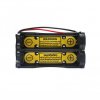That would probably work (the price works

).
It is probably regulated at 8.4 volts, which is appropriate, but the CC/CV charging profile will probably not be optimum.
Might be.
As the combined 2 cell voltage approaches 8.4 volts the charging current will decrease. That's good.
But it may not ever cut off like a real charger. Not a big problem if you monitor charge progress.
Charging should hit a termination and then stop. Most resume after the cells drop a small amount, but they stop.
Will this one?
The laptops I've played with hit the battery pack pretty hard, and let the pack control board cut off charging. They don't actually get into a constant voltage tapering off. I guess laptop users are too impatient

For the money (and shipping delay) buying one of those probably (see how I use that word a lot?) wouldn't be a bad idea. The 1000ma output would be a little hot for smaller cells. Stick with 18650.
Put a 5.5mm X 2.1mm jack in your mod.
Setting it up with one of their cheap volt meters (red display is the cheapest)
$1.93 0.36" Display 3-Digit 3~30V Voltage Tester for 18650 Battery - red LED at FastTech - Worldwide Free Shipping
and a timer in case you fall asleep would do fine.
Buying some of these cheapo components is good for experimentation.
The better components are often cloned and end up about as reliable as the real deal.
You mentioned "fuse". The control board has a built in current limit. The OK-R-6 for less than 10 bucks would be a good choice. It's not VW, doesn't have an OLED display, won't tune in shortwave stations (but will generate a little RF interference

). Remember that loaded voltage from your 2S pack will not be 8.4 volts. More like 8 for one puff, then 7,6 after a few more. Eventually getting down to about 7. That still leaves enough for the OKR to put out about 5.5 volts. Plan on that. There are threads on that module. I've used the OKR for some car powered pass throughs (great for long trips).
The last time I checked Digikey was cheaper (real US postage charged).
Sounds like you are looking forward to this DIY modding stuff

Postscript: You will probably find people that don't like protection circuits. Claim they fail all the time. I think that came from using low quality, low current cells (like ultrafires) a few years back and overloading them. The board cut off flow. They try to overload it again, it cuts off. Duh.
Figure it's a bad protection board. I've never had a problem with the cheap cells if I didn't load them over about 2.5 amps (where they should be operated). I think the protection circuits are very reliable. Do what they are supposed to. Since no one vapes at 6 watts anymore, better cells with a little higher current capability are the way to go.
The Ultrafires also didn't have any where near the labelled capacity, but for about $3, not bad.
Those that sell them for $10 or more are cheating us. That 3S3P pack in the earlier picture runs a 35 watt 12 volt HID ballast. Those are selected Ultrafire cells.






